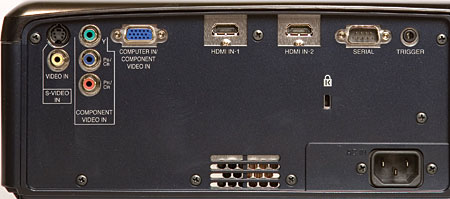Big Screens, Small Prices Mitsubishi HC6000
Back in the June 2007 issue, we looked at Mitsubishi’s $4,495 HC5000, a generally solid LCD projector that suffered from a few ergonomic and performance drawbacks. The new HC6000 is just what we like to see in a next-generation model, retaining those qualities we liked in the HC5000 while addressing the issues we encountered. And it costs $500 less, to boot.

As the highest-priced model in this roundup, the HC6000, not surprisingly, ups the ante in both features and performance. For one, it adds automatic lens-shift, zoom (1.6x), and focus controls that make setup an absolute breeze. You can access these controls on the projector’s top panel or via the small, backlit remote, which also has dedicated input buttons. Other physical setup controls include adjustable feet, keystone correction, ceiling/tabletop/front/rear configurations, and the option to project a 4:3 or 16:9 image. Automatic aspect-ratio detection is on board, as well. The menu system is easier to read than that of the HC5000, although it’s still a bit frustrating to navigate.

The HC6000 has a healthy complement of video adjustments, beginning with two lamp modes (Standard and Low) and an auto iris that offers five levels of brightness. One of our complaints about the HC5000 was the slow speed at which the auto iris made its adjustments. In the new model, I could neither hear nor see the auto-iris function with real-world content, which is good because you definitely want to use this iris. Without it, the projector’s contrast ratio was about 630:1; with it, that number improved to 4,746:1, substantially better than the other projectors in the roundup. The HC6000 strikes a great balance between black level and light output. A 0.002 ft-L black level allowed darker film content to look rich and inviting in a dark room, while a possible brightness of 12.75 ft-L helped brighter HDTV shows and sporting events look vibrant and eye-catching. The HC6000 also has a High-Brightness color temperature that further boosts light output at the expense of accuracy, but it does allow you to use the projector with some ambient room light.
 You can precisely adjust gamma and white balance via the user menu. Out of the box, the HC6000’s color temperature, at the Medium setting, tracks closest to D65 across the board. Calibration isn’t mandatory, but we slightly improved the numbers by doing so. The primary color points are all a bit oversaturated. Green, in particular, leaned enough toward yellow to alter its shading in NFL games and my Lost DVD demo. The HC5000 crushed blacks by default; thankfully, the HC6000 does not. Fine black details in The Bourne Supremacy and V for Vendetta were visible.
You can precisely adjust gamma and white balance via the user menu. Out of the box, the HC6000’s color temperature, at the Medium setting, tracks closest to D65 across the board. Calibration isn’t mandatory, but we slightly improved the numbers by doing so. The primary color points are all a bit oversaturated. Green, in particular, leaned enough toward yellow to alter its shading in NFL games and my Lost DVD demo. The HC5000 crushed blacks by default; thankfully, the HC6000 does not. Fine black details in The Bourne Supremacy and V for Vendetta were visible.
Speaking of detail, the HC6000’s better contrast ratio makes it easier to discern the excellent detail in high-definition sources, and upconverted SD signals did not look soft. The HC6000 uses the Silicon Optix Reon-VX processing chip, and it passed my processing tests, for both 480i and 1080i. The projector correctly deinterlaces 1080i and picks up 3:2. The HDMI inputs accept both 1080p/60 and 1080p/24 signals, and the projector outputs 1080p/48 when receiving a 1080p/24 signal, for a smoother, less juddery presentation. The HC6000 had no trouble with the Venetian-blind torture test in the Bourne Identity DVD, but I found that it picks up 3:2 a little faster when set for the Film mode, as opposed to the Auto mode. The only processing issue came with the text-crawl demo on the Silicon Optix HQV Benchmark DVD, which the HC6000 struggled with no matter which processing mode I selected.
The menu includes temporal, mosquito, and block-artifact noise reduction for standard-def signals only. The noise reduction provided some improvement with DirecTV SD signals, but otherwise I didn’t need to utilize these controls. As with its predecessor, one of the HC6000’s strengths is its ability to render a very clean image with almost no digital noise.
Like the Sanyo LCD projector, the Mitsubishi exhibits motion blur with faster-moving content. Also, an all-white test pattern revealed a lack of color uniformity across the screen; I saw a greenish tint to the left and a reddish tint to the right, but it was subtle enough not to adversely affect real-world content. Finally, my HC6000 had a round, green dot in the lower left quadrant of the screen, which I assume was a defect in the sample, but you should be on the lookout just in case. On the positive side, the HC6000 is very quiet in the Low lamp mode, which is the mode that produces the best contrast ratio.
Yes, the HC6000 is $1,000 more than its closest competitor in this roundup. Nonetheless, its performance, features, and versatility justify the price increase. It may not have the color accuracy and high contrast ratio of the best mid- and high-end projectors, but the HC6000 is a great all-purpose projector that can give some higher-priced competitors a real run for their money.
- Log in or register to post comments






























































